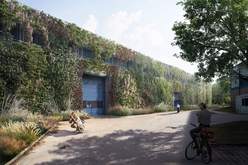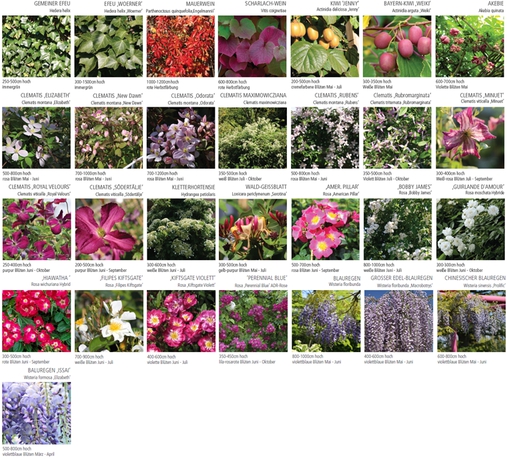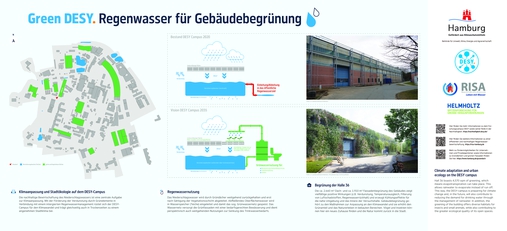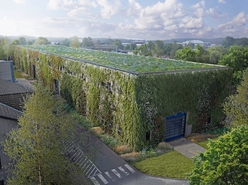Green DESY
Sustainability
Green DESY
Further links
Greening of buildings has many functions
The DESY Campus
Since its foundation more than 60 years ago, excellent and pioneering research is being carried out at DESY. In the course of this, the campus of about 57 hectares in Hamburg Bahrenfeld underwent a permanent change. The campus is characterised mainly by its accelerator facilities which are used by scientists from all over the world. The refurbishment and building of research facilities and administration buildings generated and still produces a considerable building densification and soil sealing.
This makes it all the more important to restore space to nature on the campus. Together with the environmental authorities of the City of Hamburg, one of the largest façade and roof greening projects will be started on our research campus in the Hanseatic city. Here, the walls and the roof of research building 36 will be extensively greened. These are 4,570 square meters, almost a half hectare of flowery meadow at the building.
Street view at the beginning (left) and in a few years (right)
Draft: L+ Landschaftsarchitekten
Visualization: luminousfields
Hall 36
The greening is part of the Green DESY programme; it supports biodiversity through appropriate green water management in combination with roof and façade greening. Thus, DESY contributes to sustainable urban development and promotes the general working and living conditions on the campus. Green DESY fits into the green roof strategy of Hamburg and into the RISA (RainInfraStructureAdaptation) project of the Hamburg authority for environment and energy and of the Hamburg Wasser water supply and water disposal company and is partly funded by them.
Greening of Hall 36 in figures
- Total area of greening 4,570 m²
- Roof (extensive): 2,660 m²
- Plant climbing rope system at south/east façade (ground-based) - 290 m²
- Climbing lattice in front of west façade - 1.380 m² (ground-based - 105 m) (in boxes above door and gate - 20 m)
- Direct greening at north façade (ground-based) - 240 m²
Benefits of façade and roof greening
The advantages of facade and roof greening are evident: they hold back the rain, absorb fine dust, reduce noise and nitrogen oxides. The insulation of the greened wall helps to cool down urban heat in summer because the plants evaporate water and humidify and cool down the dry air of the city. Therefore, greening produces a healthy microclimate and increases the comfort factor of users.
The green cover is also advantageous for the climate in the interior of buildings. With the additional mass of the substrate structure (roof- and façade-bound greening) and the foliage with air pockets, the heat value of the building improves considerably. On hot days, the interior remains cool while in winter the heat is kept inside which reduces the heating energy required.
Moreover, façade and roof greening offer a habitat for many insects and birds, thus contributing to biodiversity. The selection of plants ensures a varied mix and native species to create numerous breeding and food habitats. The biodiversity of fauna will be supported by voluminous and extensive planting.
Wall greening offers habitats particularly to bush- and to some extent to tree-breeding species which are gradually decreasing in cities. Insects living in climbing plants are an indispensable nutrition source for birds and bats. For example, climbing hydrangea, clematis, woodbine and ivy are preferred biotops for beetles, lice and other insects and therefore food habitats for birds.
Last but not least, we too profit from roof and façade greening. Green places and nature are strongly associated with relaxation and a pleasant atmosphere. Simultaneously, the foliage of façade greening absorbs a considerable amount of noise, thus creating peaceful areas on the campus.
Rainwater
Greening will also produce a more efficient rainwater management by increasing water seepage and evaporation possibilities. In the future, rainwater will not be discharged to the sewer any more at DESY, it will evaporate on site or be used for irrigation. First installations for rainwater retention and seepage and a green water ring connecting the individual seeping reservoirs (ponds) have already been implemented. Moreover, there are plans for additional façade and roof greening.
Rainwater is widely retained by greened roofs, it evaporates and is only drained when the vegetation layer is saturated. The runoff of surface water is discharged into ponds to supply the green water network. The green water network is then used for the adequate façade irrigation.
Water courses, water surfaces and their shore zones belong to the most species-rich habitats in the city and they are especially important for the biotope network. The aim is to establish species-rich aquatic biospheres and habitats for insects and birds. A relatively constant water level and continuous irrigation generate stable growth conditions for plants. Later, these create a living environment for various species.
Scientific monitoring
Energy efficient cooling of buildings becomes increasingly important. In order to reach the German climate protection and energy policy goals – according to the Climate Action Plan 2050 – climatisation of building plays a central role as well. Before using and optimizing conventional systems (compression cooling, ad-/absorption cooling), the use of alternative cooling concepts should have priority.
For this reason, with the hall 36 façade and roof greening project, DESY participates in a research project of Technische Universität(TU) Berlin on energy efficient cooling of buildings. With the greening of hall 36, DESY presents an alternative cooling concept for investigation. DESY is one of 11 participants submitting different ways of cooling of buildings for evaluation.
The project’s research approach is to compare several different systems in different buildings. This enables a broader analysis and assessment of potential. The buildings will also be investigated with regard to their overall performance, particularly by associating energy efficient cooling with additional energy consumption of the buildings and by including comfort aspects.
Within the framework of the research project, an open source software tool will be developed for the configuration and calculation of regenerative procedures of building cooling. With the evaluation and optimisation of the systems and with the successful implementation of the acquired measures, operators and users of the investigated buildings get the possibility to minimize costs by reducing the operating expenses. The developed panning tools enable technical building equipment planners to create and apply energy efficient cooling concepts.
The results of this research project will be published regularly on this website.
Bird's eye view at the beginning (left) and in a few years (right)
Draft: L+ Landschaftsarchitekten
Visualization: luminousfields
Future vision
The greening of hall 36 is only a first step within the framework of Green DESY. The experience with such a large-scale greening will be incorporated in the future planning on the campus in Hamburg and also in Zeuthen (near Berlin). Both locations must cope with a wide range of requirements. Apart from technical requirements, open spaces design and closeness to nature play a role. These factors must be taken into consideration from the sustainability perspective. Rainwater seepage and biodiversity are just as important as the quality of urban spaces and bicycle parking.



